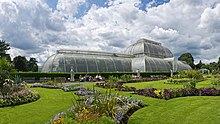
The National Botanic Gardens is a botanical garden in Glasnevin, 5 km north-west of Dublin city centre, Ireland. The 19.5 hectares are situated between Glasnevin Cemetery and the River Tolka where it forms part of the river's floodplain.

Sir Joseph Paxton was an English gardener, architect, engineer and Member of Parliament, best known for designing the Crystal Palace and for cultivating the Cavendish banana, the most consumed banana in the Western world.

Sir William Jackson Hooker was an English botanist and botanical illustrator, who became the first director of Kew when in 1841 it was recommended to be placed under state ownership as a botanic garden. At Kew he founded the Herbarium and enlarged the gardens and arboretum. The standard author abbreviation Hook. is used to indicate this person as the author when citing a botanical name.

Decimus Burton was one of the foremost English architects and landscapers of the 19th century. He was the foremost Victorian architect in the Roman revival, Greek revival, Georgian neoclassical and Regency styles. He was a founding fellow and vice-president of the Royal Institute of British Architects, and from 1840 architect to the Royal Botanic Society, and an early member of the Athenaeum Club, London, whose clubhouse he designed and which the company of his father, James Burton, the pre-eminent Georgian London property developer, built.
The year 1848 in architecture involved some significant events.
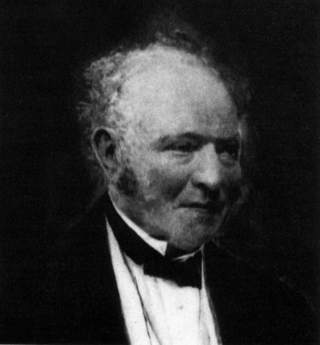
Richard Turner (1798–1881) was an Irish iron founder and manufacturer of glasshouses, born in Dublin. He is rated as one of the most important glasshouse designers of his time. His works included the Palm House at Kew Gardens, the glasshouse in the Winter Gardens at Regent's Park in London, the Palm House at Belfast Botanic Gardens and the Curvilinear Range at the Irish National Botanic Gardens, Glasnevin, Ireland.

A conservatory is a building or room having glass or other transparent roofing and walls, used as a greenhouse or a sunroom. Usually it refers to a space attached to a conventional building such as a house, especially in the United Kingdom. Elsewhere, especially in America, it can often refer to a large freestanding glass-walled building in a botanic garden or park, sometimes also called a palm house if tall enough for trees. Municipal conservatories became popular in the early 19th century.
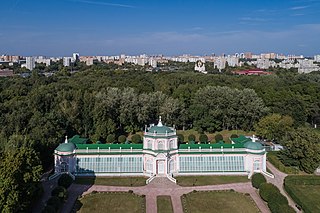
An orangery or orangerie is a room or dedicated building, historically where orange and other fruit trees are protected during the winter, as a large form of greenhouse or conservatory. In the modern day an orangery could refer to either a conservatory or greenhouse built to house fruit trees, or a conservatory or greenhouse meant for another purpose.

The Royal Botanic Garden, Sydney is a heritage-listed major 30-hectare (74-acre) botanical garden, event venue and public recreation area located at Farm Cove on the eastern fringe of the Sydney central business district, in the City of Sydney local government area of New South Wales, Australia.
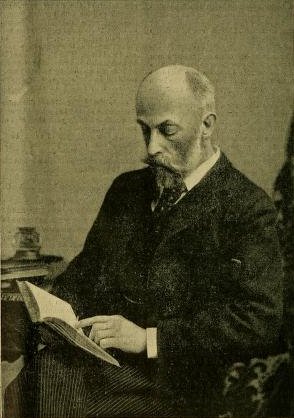
Sir William Turner Thiselton-Dyer was a leading British botanist, and the third director of the Royal Botanic Gardens, Kew.
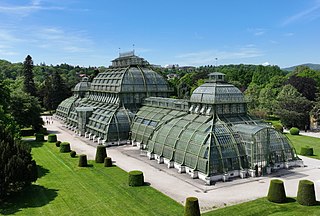
Palm house is a term sometimes used for large and high heated display greenhouses that specialise in growing palms and other tropical and subtropical plants. In Victorian Britain, several ornate glass and iron palm houses were built in botanical gardens and parks, using cast iron architecture. Especially in English-speaking countries outside the British Isles, these are often called conservatories, in the UK mainly a term for small glass structures attached to houses.
Gustav Mann (1836–1916) was a German botanist who led expeditions in West Africa and was also a gardener at the Royal Botanic Gardens, Kew.

The Royal Greenhouses of Laeken are a vast complex of monumental heated greenhouses in the park of the Royal Palace of Laeken, Belgium. The historic complex contains tropical, subtropical and cold greenhouses, and is home to the famous Royal Botanic Collection, which includes large collections of camellias, orange trees and many plants originating from the African parts of the former Belgian Empire.

Alphonse Hubert François Balat was a Belgian architect.

Kew Gardens is a botanic garden in southwest London that houses the "largest and most diverse botanical and mycological collections in the world". Founded in 1840, from the exotic garden at Kew Park, its living collections include some of the 27,000 taxa curated by Royal Botanic Gardens, Kew, while the herbarium, one of the largest in the world, has over 8.5 million preserved plant and fungal specimens. The library contains more than 750,000 volumes, and the illustrations collection contains more than 175,000 prints and drawings of plants. It is one of London's top tourist attractions and is a World Heritage Site.

The Enid A. Haupt Conservatory is a greenhouse at the New York Botanical Garden (NYBG) in the Bronx, New York, United States. The conservatory was designed by Lord & Burnham Co. in the Italian Renaissance style. Its major design features are inspired by the Palm House at the Royal Botanic Gardens at Kew, and Joseph Paxton's Crystal Palace.

The Wüstenhaus Schönbrunn is a desert botanical exhibit in Vienna, Austria. It is located in the Sonnenuhrhaus, which was built in 1904 as the newest of the four botanical houses in Schönbrunn Palace Park. The desert exhibit opened in 2004 as a counterpart to the “Rainforest House” that opened in 2002 in the nearby Zoo Vienna.

The Palmenhaus Schönbrunn is a large greenhouse in Vienna, Austria featuring plants from around the world. It opened in 1882. It is the most prominent of the four greenhouses in Schönbrunn Palace Park, and is also among the largest botanical exhibits of its kind in the world, with around 4,500 plant species.

The Hill Garden is a historic botanical garden, one of the gardens of the Herrenhäuser Gärten, around the residence Herrenhäuser Schloss in Herrenhausen, now part of Hanover, Lower Saxony, Germany. The garden was first created in 1666 as a vegetable garden on a hill north of the palace, and then transformed into a garden for exotic plants. In 1750, it was developed into a botanical garden, with some unusual trees from the period still surviving. It features a palm house, first built in 1846, and a mausoleum, where members of the royal family were interred. Damaged by air raids in World War II, the gardens were restored. In 2000, a house for rain forest-themed gardens was added, which was transformed to an aquarium in 2007.

The Temperate House, opened in May 1863, is a Grade I-listed showhouse for the largest plants in Kew Royal Botanic Gardens. Rectangular, with pitched roofs, its pillars support wrought-iron ribs. Decimus Burton and Irish engineer, Richard Turner, the designers, gave the House a mix of decorative motifs, finials, pediments, acanthus leaf capitals, Coade stone urns and statues. According to Greg Redwood, Kew's head of glasshouses, "The effect is similar to the contemporary iron pier pavilions of Eugenius Birch."
